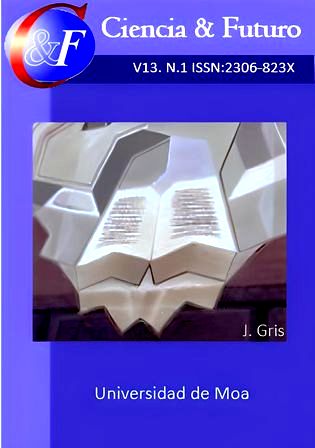Prevalence and characterization of neonatal jaundice at hospital of Moa between January and March 2022
Keywords:
neonatal jaundice, hyperbilirubin, newborn, ABO isoimmunization, prevalence, Moa municipality.Abstract
Jaundice (hyperbilirubin) usually occurs in newborns during the first week of life and constitutes the most frequent diagnosis in the Neonatology service. An observational, descriptive and transversal study of neonates diagnosed with jaundice in the hospital between January and March 2022 was carried out. It was found that of the total number of live newborns in the trimester (227), twenty neonates had clinical signs of jaundice or bilirubin values above normal, for a prevalence of this condition in the trimester analyzed of 8.8 %. Seventy percent of poblation had physiological jaundice, which reflects that this condition is not a relevant health problem in the municipality, since the prevalence of pathological variants (0,026) is below 3 %.Downloads
References
BALLARÍN, A., LORENZO, M., CABALLERO, Y., NAVARRO, R., JIMÉNEZ, I. & NAVARRO, M. (2021). Plan de cuidados de la ictericia neonatal. Revista sanitaria de investigación, 2(6), 5.
CAMPO, A., ALONSO, R. M., AMADOR, R., BALLESTÉ, I., DÍAZ, R. & REMY PÉREZ, M. (2010). Hiperbilirrubinemia neonatal agravada. Revista Cubana de Pediatría, 82(3),13-19.
ESAN, D., MUHAMMAD, F., OGUNKORODE, A. OBIALOR, B. & RAMOS, C. (2022). Creencias tradicionales en el manejo y prevención de la ictericia neonatal en Ado-Ekitini (Nigeria). Enfermería clínica, 32, 73-76.
GALLARDO, D., SANGUIL, P., CEBALLOS, M. & ROSARIO, K. (2020). Factores de riesgo asociados a hiperbilirrubinemia neonatal. RECIAMUC, 4(3), 216-226.
IZAGUIRRE, M. C., PLANAS, A. E., VIDAL, I. G., MEDRANO, P. B., GONZÁLEZ, R. & FIDALGO, N. L. (2021). Ictericia neonatal. Revista Sanitaria de Investigación, 2(12), 316.
MAY, S., HERNÁNDEZ, N. & MADERA, G. J. (2022). Efectividad de la fototerapia con luz led para disminuir hiperbilirubinemia neonatal en pacientes críticos. Revista Salud y Bienestar social, 6(1), 79-88.
MAZZI, E. (2005). Hiperbilirrubinemia neonatal. Revista de la Sociedad Boliviana de Pediatría, 44(1), 26-35.
OMEÑACA, F. & GONZÁLEZ, M. (2014). Ictericia neonatal. Pediatría Integral, 18(6), 367-374.
PINOS, P. & ALTAMIRANO, J. (2022). Fototerapia neonatal: Vigilando la dosis óptima. Revista Ecuatoriana de Pediatría, 23(3), 174-182.
REBOLLAR, J. A., ESCOBEDO, P. & FLORES, G. (2017). Etiología de ictericia neonatal en niños ingresados para tratamiento con fototerapia. Revista Mexicana de Pediatría, 84(3), 88-91.
RODRÍGUEZ, J. & FIGUERAS, J. (2008). Ictericia neonatal. Protocolos Diagnóstico Terapéuticos de la Asociación Española de Pediatría: Neonatología, 38, 372-383. Disponible en: www.aaeped.es/protocolos/.
TAIPE, A., TOAQUIZA, A. & MERCHÁN, G. (2022). Icetericia neonatal a Nivel de América Latina. FACSALUD-UNEIMI, 6(10), 76-84.
ULLAH, S., RAHMAN, K. & HEDAYATI, M. (2016). Hyperbilirubinemia in neonates: Types, causes, clinical examinations, preventive measures and treatments: A narrative review article. Iranian Journal of Public Health, 45(5), 558.
Published
How to Cite
Issue
Section
Copyright (c) 2023 Denise Rojas-Fuentes, Deliannis Torres-Legrá

This work is licensed under a Creative Commons Attribution-NonCommercial 4.0 International License.
Esta obra está bajo una Licencia Creative Commons Reconocimiento-NoComercial 4.0 Internacional
La Revista Ciencia & Futuro es una revista de acceso abierto, todo el contenido está disponible gratuitamente sin cargo para el usuario o su institución. Los usuarios pueden leer, descargar, copiar, distribuir, imprimir, buscar o vincular los textos completos de los artículos, o utilizarlos para cualquier otro fin lícito, sin pedir permiso previo al editor o al autor. Todo lo anterior, de acuerdo con la definición de BOAI de acceso abierto.
Los autores que publican en esta revista están de acuerdo con los siguientes términos: Licencia Creative Commons Atribución-NoComercial permite que el beneficiario de la licencia tenga el derecho de copiar, distribuir, exhibir y representar la obra y hacer obras derivadas para fines no comerciales siempre y cuando reconozca y cite la obra de la forma especificada por el autor o el licenciante. Los autores pueden establecer por separado acuerdos adicionales para la distribución no exclusiva de la versión de la obra publicada en la revista (por ejemplo, situarlo en un repositorio institucional o publicarlo en un libro), con un reconocimiento de su publicación inicial en esta revista. Se permite y se anima a los autores a difundir sus trabajos electrónicamente (por ejemplo, en repositorios institucionales o en su propio sitio web) antes y durante el proceso de envío, ya que puede dar lugar a intercambios productivos, así como a una citación más temprana y mayor de los trabajos publicados (Véase The Effect of Open Access) (en inglés). Lo anterior debe realizarse siempre sobre el artículo ya publicado por Ciencia & Futuro.
Los autores mantienen el control sobre la integridad de sus trabajos y el derecho a ser adecuadamente reconocidos y citados.
A los editores se les otorgan derechos no exclusivos para publicar y distribuir.







